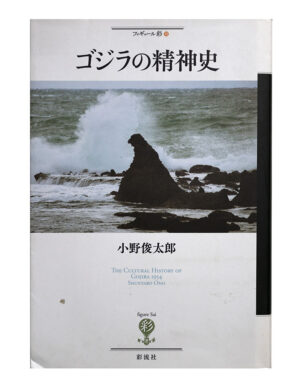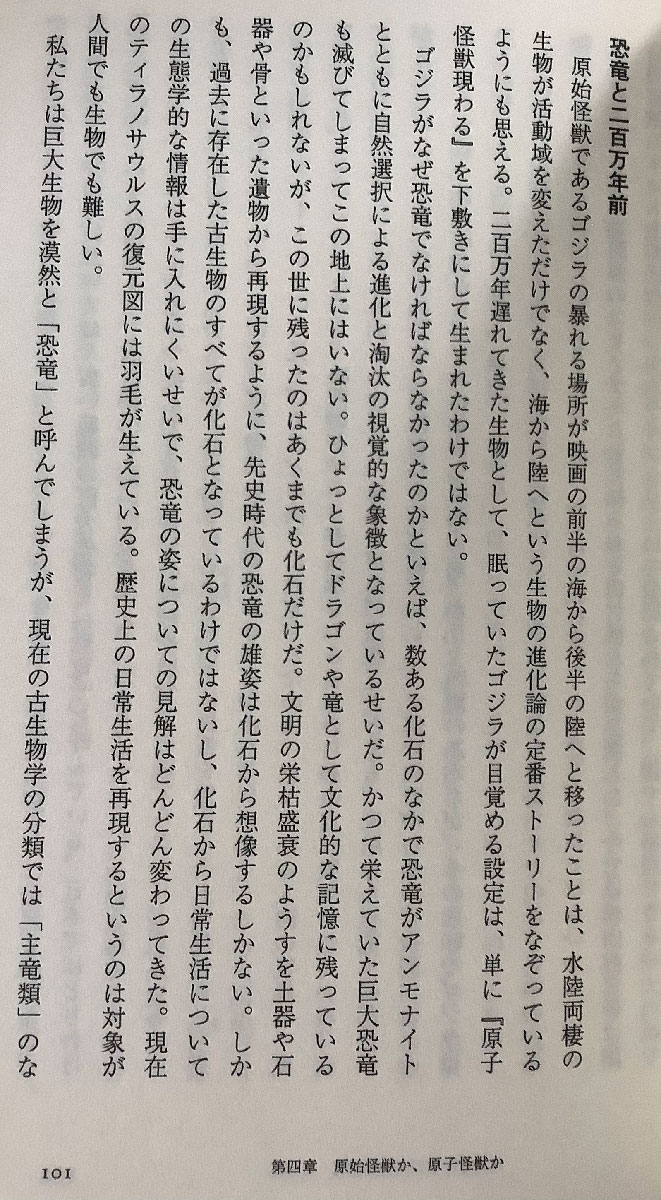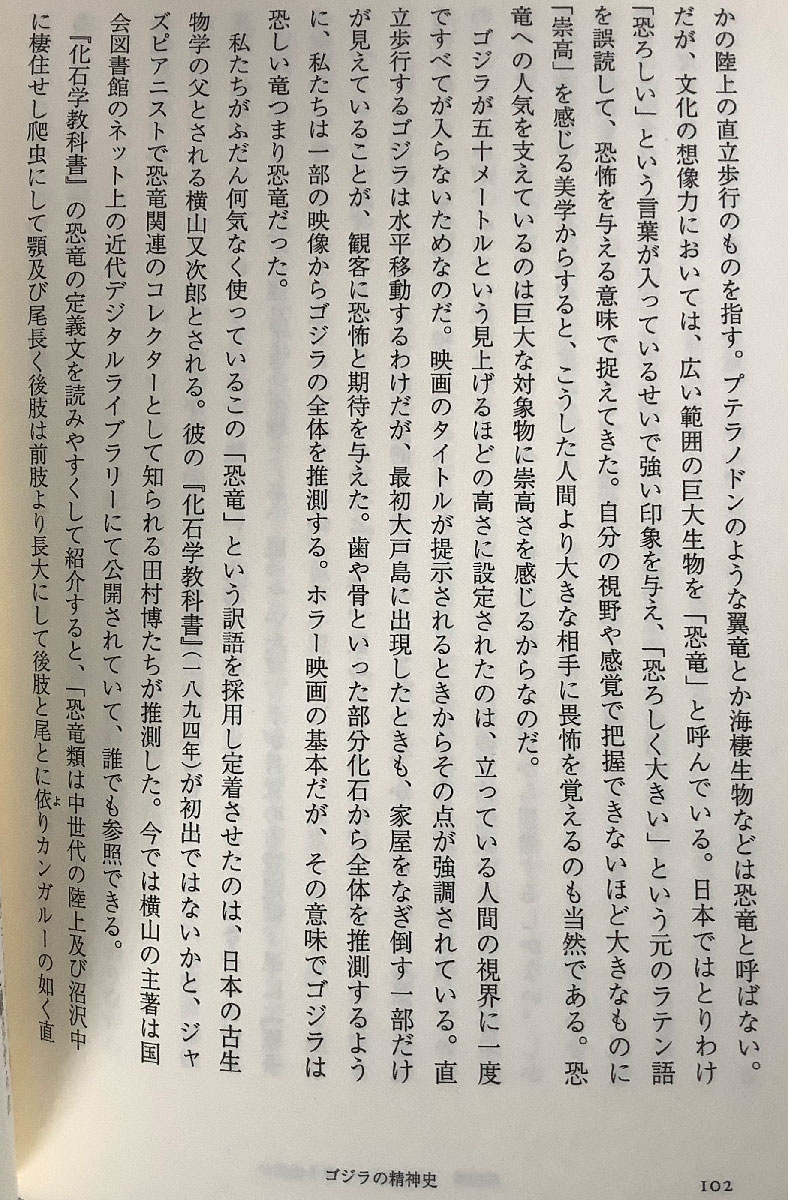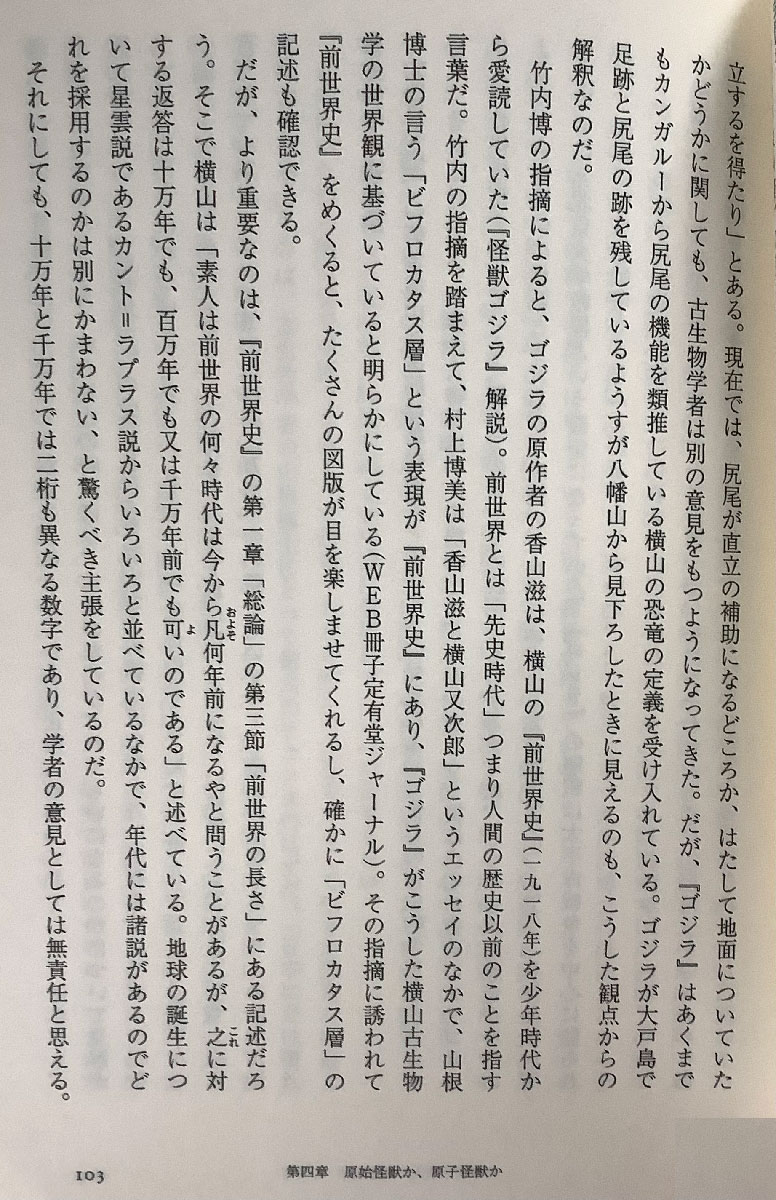4.28.2023
The Cultural History of Godzilla – Pt 40


P 101
恐竜と二百万年前
Dinosaurs and two million years ago
原始怪獣であるゴジラの暴れる場所が映画の前半の海から後半の陸へと移ったことは、水陸両棲の生物が活動域を変えただけでなく、海から陸へという生物の進化論の定番ストーリーをなぞっているようにも思える。二百万年遅れてきた生物として、眠っていたゴジラが目覚める設定は、単に『原子怪獣現わる』を下敷きにして生まれたわけではない。
The fact that the primitive monster Godzilla’s rampage moved from the sea in the first half of the movie to the land in the second half not only changed the active area of amphibious creatures, but also the classic story of the evolutionary theory of life from the sea to the land. It seems to be tracing the As a creature that has been delayed for two million years, the setting where sleeping Godzilla wakes up was not simply based on “The Beast from 20,000 Fathoms.”
ゴジラがなぜ恐竜でなければならなかったのかといえば、数ある化石のなかで恐竜がアンモナイトとともに自然選択による進化と淘汰の視覚的な象徴となっているせいだ。かつて栄えていた巨大恐竜も滅びてしまってこの地上にはいない。ひょっとしてドラゴンや竜として文化的な記憶に残っているのかもしれないが、この世に残ったのはあくまでも化石だけだ。文明の栄枯盛衰のようすを土器や石器や骨といった遺物から再現するように、先史時代の恐竜の雄姿は化石から想像するしかない。しかも、過去に存在した古生物のすべてが化石となっているわけではないし、化石から日常生活についての生態学的な情報は手に入れにくいせいで、恐竜の姿についての見解はどんどん変わってきた。現在のティラノサウルスの復元図には羽毛が生えている。歴史上の日常生活を再現するというのは対象が人間でも生物でも難しい。
The reason why Godzilla had to be a dinosaur is that dinosaurs, along with ammonites, have become visual symbols of evolution and selection by natural selection among many fossils. The giant dinosaurs that once prospered have perished and are no longer on this earth. It may have remained in cultural memory as a dragon or a dragon, but all that remains in this world are fossils. Just as we reproduce the rise and fall of civilizations from relics such as pottery, stone tools, and bones, we can only imagine the majestic appearance of prehistoric dinosaurs from fossils. What’s more, not all paleontological creatures that existed in the past are fossilized, and the lack of ecological information about everyday life from fossils has led to ever-changing views on what dinosaurs looked like. A reconstruction of the current Tyrannosaurus has feathers. Recreating everyday life in history is difficult regardless of whether the subject is a human being or a living creature.
私たちは巨大生物を漠然と「恐竜」と呼んでしまうが、現在の古生物学の分類では「主竜類」のなかの陸上の直立歩行のものを指す。
We loosely refer to giant creatures as “dinosaurs,” but modern paleontological classification refers to the upright walking on land of the “archosaurs.”

P 102
プテラノドンのような翼竜とか海棲生物などは恐竜と呼ばない。だが、文化の想像力においては、広い範囲の巨大生物を「恐竜」と呼んでいる。日本ではとりわけ「恐ろしい」という言葉が入っているせいで強い印象を与え、「恐ろしく大きい」という元のラテン語を誤読して、恐怖を与える意味で捉えてきた。自分の視野や感覚で把握できないほど大きなものに「崇高」を感じる美学からすると、こうした人間より大きな相手に畏怖を覚えるのも当然である。恐竜への人気を支えているのは巨大な対象物に崇高さを感じるからなのだ。
Pterosaurs like Pteranodon and sea creatures are not called dinosaurs. But the cultural imagination calls a wide range of giant creatures “dinosaurs.” In Japan, the word “terrible” has given a strong impression, and the original Latin word “terrifyingly big” has been misread and regarded as having a terrifying meaning. From the aesthetics of feeling “sublime” in things that are too big to be grasped by one’s own vision and senses, it is natural to feel awe of such larger-than-human opponents. Dinosaurs are popular because they feel sublime in giant objects.
ゴジラが五十メートルという見上げるほどの高さに設定されたのは、立っている人間の視界に一度ですべてが入らないためなのだ。映画のタイトルが提示されるときからその点が強調されている。直立歩行するゴジラは水平移動するわけだが、最初大戸島に出現したときも、家屋をなぎ倒す一部だけが見えていることが、観客に恐怖と期待を与えた。歯や骨といった部分化石から全体を推測するように、私たちは一部の映像からゴジラの全体を推測する。ホラー映画の基本だが、その意味でゴジラは恐しい竜つまり恐竜だった。
The reason why Godzilla was set at a height of 50 meters, which is enough to look up, is because it is impossible for a standing human to see everything at once. The point is emphasized from the moment the movie title is presented. Godzilla walks upright and moves horizontally, but even when he first appeared on Odo Island, the fact that only part of the house was knocked down gave the audience fear and anticipation. Just as we guess the whole from partial fossils such as teeth and bones, we guess the whole Godzilla from some images. It’s the basis of horror movies, but in that sense Godzilla was a scary dragon or dinosaur.
私たちがふだん何気なく使っているこの「恐竜」という訳語を採用し定着させたのは、日本の古生物学の父とされる横山又次郎とされる。彼の『化石学教科書』(一八九四年)が初出ではないかと、ジャズピアニストで恐竜関連のコレクターとして知られる田村博たちが推測した。今では横山の主著は国会図書館のネット上の近代デジタルライブラリーにて公開されていて、誰でも参照できる。
Matajiro Yokoyama, who is considered the father of Japanese paleontology, is credited with adopting and establishing the term “dinosaur,” which we use casually. Hiroshi Tamura, a jazz pianist and dinosaur-related collector, speculated that his “Textbook of Fossil Sciences” (1894) was the first to appear. Today, Yokoyama’s major works are open to the public in the Modern Digital Library on the Internet of the National Diet Library, and anyone can refer to them.
『化石学教科書』の恐竜の定義文を読みやすくして紹介すると、「恐竜類は中世代の陸上及び沼沢中に棲住せし爬虫にして顎及び尾長く後肢は前肢より長大にして後肢と尾とに依りカンガルーの如く直立するを得たり」とある。
To make it easier to read, the definition of dinosaurs in the “Textbook of Fossil Sciences” is introduced as follows: “Dinosaurs are reptiles that live on land and in swamps in the middle generation, have long jaws and long tails, and have hind limbs that are longer than the forelimbs. It was able to stand upright like a kangaroo by its tail.”

P 103
現在では、尻尾が直立の補助になるどころか、はたして地面についていたかどうかに関しても、古生物学者は別の意見をもつようになってきた。だが、『ゴジラ』はあくまでもカンガルーから尻尾の機能を類推している横山の恐竜の定義を受け入れている。ゴジラが大戸島で足跡と尻尾の跡を残しているようすが八幡山から見下ろしたときに見えるのも、こうした観点からの解釈なのだ。
Paleontologists now have differing opinions as to whether the tail was even on the ground rather than helping it stand upright. However, “Godzilla” accepts Yokoyama’s definition of a dinosaur, analogizing the function of a tail from a kangaroo. It is from this perspective that you can see Godzilla leaving footprints and tail marks on Odo Island when looking down from Mt. Hachiman.
竹内博の指摘によると、ゴジラの原作者の香山滋は、横山の『前世界史』(一九一八年)を少年時代か愛読していた(『怪獣ゴジラ』解説)。前世界とは「先史時代」つまり人間の歴史以前のことを指す言葉だ。竹内の指摘を踏まえて、村上博美は「香山滋と横山又次郎」というエッセイのなかで、山根博士の言う「ビフロカタス層」という表現が『前世界史』にあり、『ゴジラ』がこうした横山古生物学の世界観に基づいていると明らかにしている(WEB冊子定有堂ジャーナル)。その指摘に誘われて『前世界史』をめくると、たくさんの図版が目を楽しませてくれるし、確かに「ビフロカタス層」の記述も確認できる。
According to Hiroshi Takeuchi, the author of Godzilla, Shigeru Kayama, loved to read Yokoyama’s “Foreworld History” (1918) when he was a boy (“Kaiju Godzilla” commentary). The term “prehistoric” refers to the “prehistoric period,” or the period before human history. Based on Takeuchi’s point, Hiromi Murakami wrote in an essay titled “Shigeru Kayama and Matajiro Yokoyama” that Dr. Yamane’s expression “Bifrocatas layer” is found in “Zensekaishi,” and “Godzilla” is based on Yokoyama’s paleontology. It is based on the world view of (WEB booklet Teiyudou Journal). Invited by that point, when I flipped through “Pre-World History,” many illustrations were pleasing to the eye, and I could certainly confirm the description of the “Bifrocatas Formation.”
だが、より重要なのは、『前世界史』の第一章「総論」の第三節「前世界の長さ」にある記述だろう。そこで横山は「素人は前世界の何々時代は今から何年前になるやと問うことがあるが、之に対する返答は十万年でも、百万年でも又は千万年前でも可いのである」と述べている。地球の誕生について星雲説であるカント=ラプラス説からいろいろと並べているなかで、年代には諸説があるのでどれを採用するのかは別にかまわない、と驚くべき主張をしているのだ。
However, what is more important is the description in the third section, “Length of the previous world,” in Chapter 1, “Introduction,” of “Semi-World History.” Yokoyama then said, “A layperson may ask how many years ago this era in the previous world was, but the answer can be 100,000 years, 100,000, or 10,000,000 years. While arranging various theories about the birth of the Earth, starting with the Kant-Laplace theory, which is the nebula theory, he makes the surprising assertion that there are various theories about the age, so it does not matter which one is adopted.
The Kant-Laplace nebular hypothesis. Kant’s central idea was that the solar system began as a cloud of dispersed particles. He assumed that the mutual gravitational attractions of the particles caused them to start moving and colliding, at which point chemical forces kept them bonded together. (Source: Google)
それにしても、十万年と千万年では二桁も異なる数字であり、学者の意見としては無責任と思える。
Even so, 100,000 years and 10,000,000 years are two digits different, which seems irresponsible as a scholar’s opinion.